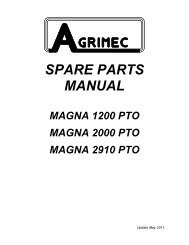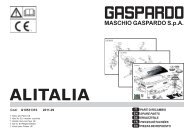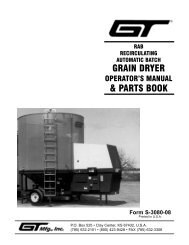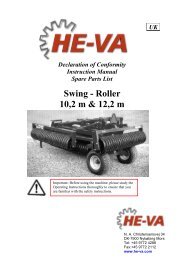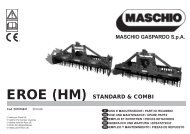MANURE PLANNING in NVZs – England (Nitrate Vulnerable Zones)
MANURE PLANNING in NVZs – England (Nitrate Vulnerable Zones)
MANURE PLANNING in NVZs – England (Nitrate Vulnerable Zones)
Create successful ePaper yourself
Turn your PDF publications into a flip-book with our unique Google optimized e-Paper software.
REVISED EDITION<br />
<strong>MANURE</strong><br />
<strong>PLANNING</strong> <strong>in</strong> <strong>NVZs</strong><br />
<strong>–</strong> <strong>England</strong><br />
<strong>Nitrate</strong><br />
<strong>Vulnerable</strong><br />
<strong>Zones</strong>
CONTENTS<br />
Page<br />
Introduction 3<br />
Part A: Is enough land available for spread<strong>in</strong>g all manure? 5<br />
Step 1: Calculate the permitted manure total N capacity for your farm 5<br />
Step 2: Calculate the amount of N produced as<br />
livestock excreta on your farm 10<br />
Step 3: Guidel<strong>in</strong>es for spread<strong>in</strong>g imported livestock<br />
manures, sewage sludge or other imported organic materials 12<br />
Part B: Is there enough storage for slurry? 13<br />
Step 4: Calculat<strong>in</strong>g the months of storage available 14<br />
Step 5: Calculate the number of months’ storage<br />
needed to hold slurry 17<br />
Part C:<br />
How much will manure applications reduce the<br />
requirement for fertiliser N? 21<br />
Step 6: Note details of manure applications and<br />
calculate total and available N applied 21<br />
APPENDICES<br />
Appendix A Environment Agency Head and Regional Offices 27<br />
Appendix B Record of livestock manures moved off the farm 28<br />
Appendix C<br />
Examples of N available to crops from applications<br />
conta<strong>in</strong><strong>in</strong>g 250 kg/ha total N, applied to the soil<br />
surface and not <strong>in</strong>corporated 29<br />
Examples of N available to crops from applications<br />
conta<strong>in</strong><strong>in</strong>g 250 kg/ha total N, and rapidly <strong>in</strong>corporated 30<br />
Appendix D Conversion tables 31<br />
1
<strong>MANURE</strong> <strong>PLANNING</strong> IN NVZS<br />
NITRATE VULNERABLE ZONES <strong>–</strong> <strong>England</strong><br />
INTRODUCTION<br />
1<br />
This booklet should be read <strong>in</strong> conjunction with the booklet ‘Guidel<strong>in</strong>es for<br />
Farmers <strong>in</strong> <strong>NVZs</strong> <strong>–</strong> <strong>England</strong>’ (NVZ 4), which expla<strong>in</strong>s all the NVZ Action<br />
Programme rules. This supplementary booklet has been prepared to help livestock<br />
farmers, and those arable farmers import<strong>in</strong>g organic manures, comply with the<br />
requirements of the Action Programme measures which must be followed from<br />
19 December 1998/2002 1 with<strong>in</strong> <strong>Nitrate</strong> <strong>Vulnerable</strong> <strong>Zones</strong> designated under the<br />
EC <strong>Nitrate</strong> Directive. For organic manures, the Action Programme places:<br />
i) Limits on the quantities of organic manure which may be applied to<br />
agricultural land;<br />
ii) Restrictions on the time of application of some manures; and<br />
iii) A requirement that full allowance is made for nitrogen (N) available<br />
from organic manures and other organic materials conta<strong>in</strong><strong>in</strong>g N when<br />
calculat<strong>in</strong>g fertiliser requirements.<br />
2<br />
These<br />
guidel<strong>in</strong>es will deal with the three aspects <strong>in</strong> turn:<br />
Part A<br />
Is enough land available for spread<strong>in</strong>g all manure?<br />
Part B<br />
Part C<br />
Is there enough storage for slurry?<br />
How much will manure applications reduce the requirement<br />
for fertiliser N?<br />
Part A need only be done once, unless your farm system changes with respect<br />
to farm area, livestock numbers or area of grassland.<br />
Part B is for farmers with slurry systems and helps you decide whether you need<br />
additional storage <strong>in</strong> order to avoid applications of slurry dur<strong>in</strong>g closed periods.<br />
Part C needs to be completed annually as manure applications and crop<br />
rotations will vary from year to year.<br />
1<br />
For <strong>NVZs</strong> designated <strong>in</strong> 1996, the NVZ Action Programme came <strong>in</strong>to force on<br />
19 December 1998. For <strong>NVZs</strong> designated <strong>in</strong> 2002, the NVZ Action Programme<br />
comes <strong>in</strong>to force on 19 December 2002.<br />
3
3<br />
The<br />
guidance given may not cover every circumstance on your farm and you<br />
may need to seek advice. Details of where you can obta<strong>in</strong> further advice are<br />
given <strong>in</strong> the booklet ‘Guidel<strong>in</strong>es for Farmers <strong>in</strong> <strong>NVZs</strong> <strong>–</strong> <strong>England</strong>’ (see<br />
paragraph 46).<br />
A computer based NVZ Decision Support System (DSS) ‘Your Farm and <strong>NVZs</strong><br />
<strong>–</strong> Do you comply?’ has been designed to provide a simple, user-friendly system<br />
to help you assess if your farm complies with the NVZ Action Programme<br />
rules. The software is an alternative to this booklet and will carry out all the<br />
necessary calculations for your farm. The DSS is available on CD-ROM free<br />
of charge. If you would like a copy telephone 0845 6023864 (NVZ technical<br />
advice helpl<strong>in</strong>e).<br />
4
PART A<br />
IS ENOUGH LAND AVAILABLE FOR SPREADING<br />
ALL <strong>MANURE</strong>?<br />
4<br />
The<br />
5<br />
Additionally,<br />
6<br />
The<br />
rules for <strong>Nitrate</strong> <strong>Vulnerable</strong> <strong>Zones</strong> set a limit for organic manure (nitrogen)<br />
load<strong>in</strong>gs of 250 kg/ha of total N on grassland, and 210 kg/ha of total N on<br />
land <strong>in</strong> non-grass crops, averaged over all agricultural land with<strong>in</strong> the NVZ on<br />
your farm. You should note that the load<strong>in</strong>g limit for land <strong>in</strong> non-grass crops <strong>in</strong><br />
<strong>NVZs</strong> reduces to 170 kg/ha N after the first four years of the Action<br />
Programme 1 . The limits <strong>in</strong>clude manure deposited by graz<strong>in</strong>g animals and N <strong>in</strong><br />
imported organic materials. These are annual limits which apply from 19<br />
December to 18 December <strong>in</strong> the follow<strong>in</strong>g year. The amount of N produced as<br />
livestock excreta depends on the number and type of livestock on your farm.<br />
no <strong>in</strong>dividual field should receive organic manure applications<br />
(which excludes manure deposited by graz<strong>in</strong>g animals) which supply more than<br />
250kg/ha of total N <strong>in</strong> any 12 month period, or supply available N <strong>in</strong> excess<br />
of the crop requirement.<br />
follow<strong>in</strong>g steps will allow you to check that you have enough land<br />
to comply with the requirements of the NVZ Action Programme.<br />
NB. Rented land: Land under short term rental agreement (usually two years<br />
or less) should be counted as part of the leasor’s farm; land under longer term<br />
rental agreements should be counted by the farm us<strong>in</strong>g the land.<br />
7<br />
This<br />
Step 1<br />
Calculate the permitted manure total N capacity<br />
for your farm<br />
allowance depends on the area of land on the farm with<strong>in</strong> the NVZ.<br />
Complete Tables 1a (grassland) and 1b (non-grass crops), list<strong>in</strong>g all fields on<br />
your farm. Your IACS map may be helpful at this stage.<br />
Column 1<br />
Column 2<br />
Column 3<br />
Field name or number<br />
Crop to be grown (to make plann<strong>in</strong>g of manure spread<strong>in</strong>g easier)<br />
The area <strong>in</strong> hectares. Add up the total areas (A and B).<br />
Note: If you only know areas <strong>in</strong> acres you will need to convert<br />
them to hectares. To do this multiply the number of acres by 0.405,<br />
e.g. 276 acres = 112 ha. A conversion table is conta<strong>in</strong>ed <strong>in</strong> Appendix D.<br />
1<br />
The reduced limit applies from 19 December 2002 for designations with the<br />
NVZ Action Programme beg<strong>in</strong>n<strong>in</strong>g on 19 December 1998; and 19 December<br />
2006 for designations with the NVZ Action Programme beg<strong>in</strong>n<strong>in</strong>g on<br />
19 December 2002.<br />
5
8<br />
9<br />
Identify<br />
10<br />
11<br />
Column 4 Is for future reference when plann<strong>in</strong>g manure applications.<br />
Note the months when manure applications are permitted and likely to be<br />
practicable, for each field.<br />
On sandy or shallow soils the NVZ Action Programme imposes a closed period<br />
of three months (1 August to 1 November) when no slurry, poultry manures or<br />
liquid digested sewage sludge may be applied to land which is not <strong>in</strong> grass nor<br />
to be sown with an autumn sown crop. The closed period for land <strong>in</strong> grass or<br />
to be sown with an autumn sown crop is 1 September to 1 November. These<br />
closed periods do not apply to FYM (straw-based manures) or other forms of<br />
sewage sludge or other organic materials.<br />
areas where spread<strong>in</strong>g may be difficult at certa<strong>in</strong> times, e.g. due to:<br />
• Grow<strong>in</strong>g crops<br />
• Poor trafficability (e.g. on clay soils <strong>in</strong> w<strong>in</strong>ter)<br />
• Risk of run-off (e.g. on clay soils, significant slopes*)<br />
*applications are not permitted on steep slopes at any time.<br />
The Code of Good Agricultural Practice for the Protection of Water gives<br />
further guidance on the tim<strong>in</strong>g of manure applications to avoid the risk of<br />
direct pollution of streams and other watercourses. You are encouraged to<br />
develop a Farm Waste Management Plan to help you decide when, where and<br />
at what rate to spread organic manures on your farm.<br />
F<strong>in</strong>ally, calculate the permitted manure total N capacity for your grassland (C)<br />
and land <strong>in</strong> non-grass crops (D 1 , or D 2 for post December 2002/2006 1 ). Add<br />
these figures together to obta<strong>in</strong> the permitted manure total N capacity for your<br />
farm (E 1 , or E 2 for post December 2002/2006 1 ).<br />
1<br />
See footnote to paragraph 4 (page 5) for the year which applies to your farm.<br />
6
Table 1a<br />
Calculat<strong>in</strong>g the area available for spread<strong>in</strong>g manure on<br />
grassland<br />
Field name or Crop Area <strong>in</strong> Months available for spread<strong>in</strong>g<br />
number (e.g. hectares manures<br />
permanent or<br />
tak<strong>in</strong>g <strong>in</strong>to account NVZ rules and<br />
ley grass)<br />
practicalities<br />
Total area A =<br />
ha<br />
Permitted manure total N capacity = A x 250 = C<br />
for your grassland:<br />
kg N per year<br />
7
Table 1b<br />
Calculat<strong>in</strong>g the area available for spread<strong>in</strong>g manure on<br />
land <strong>in</strong> non-grass crops<br />
Field name or Crop Area <strong>in</strong> Months available for spread<strong>in</strong>g<br />
number e.g. potatoes hectares manures<br />
tak<strong>in</strong>g <strong>in</strong>to account NVZ rules and<br />
practicalities<br />
Total area B =<br />
ha<br />
Permitted manure total N capacity<br />
for your land <strong>in</strong> non-grass crops:<br />
= B x 210 1 = D 1 or, for post 2002/2006 D 2<br />
= B x 170 =<br />
kg N per year<br />
1<br />
This figure will reduce to 170kg/ha N <strong>in</strong> December 2002/2006. See footnote to<br />
paragraph 4 (page 5) for the year which applies to your farm.<br />
8
Summary of Tables 1a and 1b<br />
Permitted manure total N capacity<br />
for your farm:<br />
= C + D 1<br />
= E 1 or, for post 2002/2006 E 2<br />
= C + D 2<br />
=<br />
kg N per year<br />
The figure E 2<br />
<strong>in</strong>dicates your situation after December 2002/2006 (provid<strong>in</strong>g your area of<br />
non-grass crops rema<strong>in</strong>s the same) when the allowance on land <strong>in</strong> non-grass crops<br />
reduces to 170 kg/ha of total N.<br />
9
12<br />
Step 2<br />
Calculate the amount of N produced as livestock<br />
excreta on your farm<br />
This calculation ensures that no more than the permitted quantities of manure<br />
are applied and deposited on your farm each year. Fill <strong>in</strong> Table 2. For each<br />
livestock unit:<br />
Column 1<br />
Column 2.<br />
F<strong>in</strong>d the appropriate livestock units and record their number <strong>in</strong><br />
Column 2 Multiply the number of livestock units <strong>in</strong> Column 2 by the factor <strong>in</strong><br />
Column 3, to calculate the total N produced as livestock excreta. These factors<br />
are based upon standard figures for the estimated N excretion by different<br />
classes of livestock 1 .<br />
13<br />
14<br />
15<br />
Column 4 Enter the results <strong>in</strong> Column 4. Add up Column 4 and record the<br />
total (F). This is the total N produced on your farm by livestock. Compare this<br />
with the permitted manure total N capacity for your land (E 1<br />
or E 2<br />
from Step 1).<br />
If you are produc<strong>in</strong>g more N from livestock than the permitted quantity, i.e. F is<br />
bigger than E 1<br />
, you should make arrangements to export the excess manure for<br />
use on another farm or dispose of it <strong>in</strong> another environmentally acceptable way.<br />
When dispos<strong>in</strong>g of excess manure you should always comply with the Codes of<br />
Good Agricultural Practice for the Protection of Water, Soil and Air. For future<br />
plann<strong>in</strong>g beyond December 2002/2006 compare F with E 2<br />
.<br />
If you are export<strong>in</strong>g livestock manures off the farm, it is a legal requirement<br />
that you ma<strong>in</strong>ta<strong>in</strong> acceptable records, <strong>in</strong>clud<strong>in</strong>g details of the quantities, dates<br />
of export, and details of the recipient (see paragraphs 38 and 39 of the booklet<br />
‘Guidel<strong>in</strong>es for Farmers <strong>in</strong> <strong>NVZs</strong> <strong>–</strong> <strong>England</strong>’). You must keep these records for<br />
at least five years. An example form for record<strong>in</strong>g movements of livestock<br />
manures off the farm can be found at Appendix B. You may f<strong>in</strong>d it helpful to<br />
use photocopies of this form. Typical nitrogen contents of organic manures are<br />
given <strong>in</strong> Tables 5, 6 and 7.<br />
The risk of spread<strong>in</strong>g animal disease while transport<strong>in</strong>g manures to other farms<br />
is reduced by provid<strong>in</strong>g secure conta<strong>in</strong>ment, clean<strong>in</strong>g the exterior of the vehicle<br />
used for tranport before leav<strong>in</strong>g the orig<strong>in</strong>at<strong>in</strong>g premises, and spread<strong>in</strong>g on<br />
arable land or on grassland used for forage conservation. Advice on apply<strong>in</strong>g<br />
manures to graz<strong>in</strong>g land is conta<strong>in</strong>ed <strong>in</strong> booklet No. 2 ‘Mak<strong>in</strong>g better use of<br />
livestock manures on grassland’ <strong>–</strong> see ‘Guidel<strong>in</strong>es for Farmers <strong>in</strong> <strong>NVZs</strong> <strong>–</strong><br />
<strong>England</strong>’, paragraph 52, for further details.<br />
1<br />
If you have good evidence that different figures should be used on your<br />
hold<strong>in</strong>g (e.g. use of low N diets) these may be substituted. If you opt to use<br />
different figures you should keep adequate records to support your actions.<br />
If you are currently export<strong>in</strong>g manures you should take this <strong>in</strong>to account.<br />
Output figures should also be adjusted if percentage occupancy or length<br />
of the production cycle differ from the standard values <strong>in</strong> the table.<br />
10
Table 2<br />
Standard figures for total nitrogen produced as livestock<br />
excreta<br />
Column 1 2 3 4<br />
Livestock unit Number Total N Total N<br />
of produced produced by<br />
livestock by 1 livestock all these<br />
units unit animals<br />
(kg/year) (kg/year)<br />
1 Dairy Cow (650kg) X 116 =<br />
1 Dairy Cow (550kg) X 96 =<br />
1 Dairy Cow (450kg) X 76 =<br />
1 Dairy heifer replacement over 24 months (500 kg) X 58 =<br />
1 Suckler Cow X 58 =<br />
1 Cattle grower/fattener over 24 months (500kg) X 58 =<br />
1 Cattle grower/fattener 12-24 months (400kg) X 47 =<br />
1 Young cattle 6-12 months 1 X 12 =<br />
1 Bull beef cattle 6-13.5 months X 23 =<br />
1 Calf (to 6 months) 1 X 7 =<br />
1 Bull for breed<strong>in</strong>g (1350 kg, alter figures for breed) X 58 =<br />
1 Sheep X 9 =<br />
1 Fatten<strong>in</strong>g Lamb 6 <strong>–</strong> 12 months 1 X 3.2 =<br />
1 Fatten<strong>in</strong>g Lamb 0 <strong>–</strong> 6 months 1 X 1.2 =<br />
1 Breed<strong>in</strong>g Sow place (<strong>in</strong>cludes piglets to 3.5 weeks) 2 X 19.5 =<br />
1 Maiden gilt place 2 X 13 =<br />
1 Boar place X 16 =<br />
For pigs fattened from 3.5 weeks:<br />
<strong>–</strong> Number of pigs f<strong>in</strong>ished at 7.5 weeks/18 kg 3 X 0.28 =<br />
<strong>–</strong> Number of pigs f<strong>in</strong>ished at 11 weeks/35 kg 3 X 0.77 =<br />
<strong>–</strong> Number of pigs f<strong>in</strong>ished at 20 weeks/85 kg 3 X 2.5 =<br />
<strong>–</strong> Number of pigs f<strong>in</strong>ished at 23 weeks/105 kg 3 X 3.36 =<br />
For pigs fattened from 7.5 weeks:<br />
<strong>–</strong> Number of pigs f<strong>in</strong>ished at 11 weeks/35 kg 3 X 0.49 =<br />
<strong>–</strong> Number of pigs f<strong>in</strong>ished at 20 weeks/85 kg 3 X 2.22 =<br />
<strong>–</strong> Number of pigs f<strong>in</strong>ished at 23 weeks/105 kg 3 X 3.08 =<br />
1000 Lay<strong>in</strong>g Hens (98% occupancy) X 660 =<br />
1000 Broiler Places (76% occupancy) X 495 =<br />
1000 Broiler Breeder (77% occupancy) X 975 =<br />
1000 Pullets (38% occupancy) X 125 =<br />
1000 Male Turkeys Places (140 days) 4 X 1390 =<br />
1000 Female Turkeys Places(120 days) 5 X 650 =<br />
1000 Fatten<strong>in</strong>g Duck Places (50 days) 6 X 900 =<br />
Total N produced F =<br />
1<br />
Presumes kept for only 6 months.<br />
2<br />
Average number on unit at any time dur<strong>in</strong>g the year.<br />
3<br />
Total number normally f<strong>in</strong>ished <strong>in</strong> a year assum<strong>in</strong>g pigs are on the farm from 3.5 weeks or 7.5 weeks.<br />
Figures for pigs f<strong>in</strong>ished after import at other ages can be calculated by subtraction. E.g. If pigs are<br />
imported at 35 kg and kept until 105 kg subtract total N produced by pigs f<strong>in</strong>ished at 35 kg (0.77)<br />
from total N produced by pigs f<strong>in</strong>ished at 105 kg (3.36) and use the figure of 2.59 <strong>in</strong> column 3.<br />
4<br />
Male turkeys, assum<strong>in</strong>g 2.1 crops per year; 80% occupancy.<br />
5<br />
Female turkeys, assum<strong>in</strong>g 2.4 crops per year; 80% occupancy.<br />
6<br />
Ducks, assumes 85% occupancy.<br />
Include cockerels, drakes etc. <strong>in</strong> hen/duck numbers.<br />
N.B. An alternative method of calculat<strong>in</strong>g the N excreted by pigs based on ‘pig places’ is given <strong>in</strong> 11<br />
‘Guidel<strong>in</strong>es for Farmers <strong>in</strong> <strong>NVZs</strong> <strong>–</strong> <strong>England</strong>’.
16<br />
17<br />
Step 3<br />
Guidel<strong>in</strong>es for spread<strong>in</strong>g imported livestock<br />
manures, sewage sludge or other imported organic<br />
materials<br />
You only need to read this page if you wish to br<strong>in</strong>g livestock manures from<br />
other farms, sewage sludge or other organic materials onto your farm. The risk<br />
of spread<strong>in</strong>g animal disease while transport<strong>in</strong>g manures from other farms is<br />
reduced by provid<strong>in</strong>g secure conta<strong>in</strong>ment, clean<strong>in</strong>g the exterior of equipment<br />
and spread<strong>in</strong>g on arable land or on grassland used for forage conservation.<br />
You will need to keep records of the application of imported materials on your<br />
field record sheets. Advice on apply<strong>in</strong>g manures to graz<strong>in</strong>g land is conta<strong>in</strong>ed <strong>in</strong><br />
booklet No. 2, ‘Mak<strong>in</strong>g better use of livestock manures on grassland’. See<br />
‘Guidel<strong>in</strong>es for Farmers <strong>in</strong> <strong>NVZs</strong> <strong>–</strong> <strong>England</strong>’, paragraph 52, for further details.<br />
The limit on total N as organic manure applies to all sources of organic N.<br />
Therefore you should only import organic manures or organic materials<br />
conta<strong>in</strong><strong>in</strong>g nitrogen to your farm if you have more land suitable for spread<strong>in</strong>g<br />
than you need for the manure from your own livestock (i.e. E is larger than F).<br />
Permitted manure total N Total N produced by Total N <strong>in</strong> organic<br />
capacity for your farm farm livestock manures which can be<br />
(Step 1) (Step 2) imported on to the farm<br />
E kg/year less F kg/year = kg/year<br />
18<br />
A s<strong>in</strong>gle application of sewage sludge normally conta<strong>in</strong>s 200 kg/ha N or more.<br />
However sludge N contents vary, and the supplier should provide you with an<br />
analysis and <strong>in</strong>terpretation. Some examples of the rates of different sludges<br />
which supply 250 kg/ha N, based upon typical N contents, are shown below:<br />
Type of sewage sludge Total N content Rate of application<br />
kg/tonne or<br />
supply<strong>in</strong>g 250 kg/ha<br />
kg/m 3<br />
of total N<br />
Liquid digested 2.0 125 m 3 /ha<br />
Sludge cake digested 7.5 33 t/ha<br />
Thermally dried 35 7 t/ha<br />
Lime stabilised 6 42 t/ha<br />
12
PART B<br />
IS THERE ENOUGH STORAGE FOR SLURRY?<br />
19<br />
Part B applies ONLY to farmers with<strong>in</strong> <strong>NVZs</strong> produc<strong>in</strong>g liquid slurries for<br />
which additional storage may be required <strong>in</strong> order to comply with the follow<strong>in</strong>g<br />
rules on the tim<strong>in</strong>g of the application of manures.<br />
20 On sandy (sometimes called light sand soils)1 or shallow 2 soils, slurries, poultry<br />
manures or liquid digested sewage sludge may not be applied:<br />
Between 1 September and 1 November to fields <strong>in</strong> grass or to be sown with an<br />
autumn sown crop, or<br />
Between 1 August and 1 November to fields not <strong>in</strong> grass, nor to be sown with<br />
an autumn sown crop.<br />
21<br />
22<br />
This section, together with your experience of spread<strong>in</strong>g dur<strong>in</strong>g w<strong>in</strong>ter (see<br />
paragraphs 29 and 30), will enable you to estimate the number of months of<br />
storage of slurry you will need to comply with the NVZ requirements and<br />
m<strong>in</strong>imise the risk of caus<strong>in</strong>g pollution. You will need to <strong>in</strong>clude dirty water<br />
from fouled yard areas and dairy/parlour wash water only <strong>in</strong> those cases where<br />
it dra<strong>in</strong>s to the slurry store.<br />
Liquid effluents from weep<strong>in</strong>g-wall stores, stra<strong>in</strong>er boxes, slurry separators and<br />
silage effluents are rich <strong>in</strong> nitrogen and are regarded as slurries under NVZ<br />
rules.<br />
NB. Dirty water (ra<strong>in</strong>water which has passed across fouled concrete <strong>in</strong> a<br />
farmyard or wash water from a dairy/parlour) which is collected separately<br />
from slurry is not regarded as slurry under NVZ rules and can be applied at<br />
any time on any soil subject to standard guidel<strong>in</strong>es as given <strong>in</strong> the Code of<br />
Good Agricultural Practice for the Protection of Water.<br />
1 A sandy soil (also known as light sand soil) has a sand, loamy sand or sandy<br />
loam topsoil to 40cm depth overly<strong>in</strong>g a sand or loamy sand subsoil to 80 cm<br />
depth. The topsoil will conta<strong>in</strong> less than 8.5% organic matter (5.0% organic<br />
carbon).<br />
2 A shallow soil is less than 40 cm deep over rock which is commonly chalk,<br />
limestone or sandstone <strong>in</strong> <strong>NVZs</strong>.<br />
13
23<br />
24<br />
Step 4<br />
Calculat<strong>in</strong>g the months of storage available<br />
You may already know how many months of slurry production you can store<br />
on your farm. If so, record this at Box Z and move to Step 5.<br />
If you do not know how many months’ storage you have, this can be estimated<br />
by follow<strong>in</strong>g the steps below. To calculate storage available you need to know:<br />
1. The capacity of exist<strong>in</strong>g slurry storage facilities (<strong>in</strong> cubic metres).<br />
2. The area of open yards, silage clamps etc. which dra<strong>in</strong> <strong>in</strong>to the slurry store<br />
(<strong>in</strong> square metres).<br />
3. The average annual ra<strong>in</strong>fall for your farm (<strong>in</strong> millimetres).<br />
These conversion factors may<br />
be useful <strong>in</strong> these calculations:<br />
1000 gallons = 4.55 m 3 (cubic metres)<br />
1 square yard = 0.84 m 2 (square metres)<br />
1 <strong>in</strong>ch = 25.4 mm (millimetres)<br />
25<br />
To calculate the monthly volume of slurry produced fill <strong>in</strong> Table 3. Record the<br />
follow<strong>in</strong>g:<br />
Column 1 The number of livestock units on slurry or part slurry based<br />
systems.<br />
Column 2 If some of the excreta are collected as solid manures and stored<br />
separately estimate the proportion handled as slurry <strong>in</strong> this column. Otherwise<br />
ignore this column or set it equal to 1.<br />
Column 3 This is the multiplication factor to give monthly volumes.<br />
Column 4 Multiply together Columns 1, 2 and 3 and enter the results <strong>in</strong> this<br />
column. Add up the figures <strong>in</strong> Column 4 and enter <strong>in</strong>to Box S, the total volume<br />
of slurry produced per month.<br />
14
Table 3 Slurry production per month (based on undiluted slurry 1 )<br />
Column 1 2 3 4<br />
Livestock unit Number of Proportion Volume per Total<br />
on slurry based system livestock units of waste livestock unit volume<br />
on slurry or collected as per month produced<br />
part slurry- slurry m 3 each<br />
based system e.g Half = 0.5, month<br />
Cattle<br />
1 Dairy Cow (650 kg) X X 1.93 =<br />
1 Dairy Cow (550 kg) X X 1.61 =<br />
1 Dairy Cow (450 kg) X X 1.28 =<br />
1 Dairy heifer replacement<br />
over 24 months (500 kg) X X 0.98 =<br />
1 Suckler cow X X 0.98<br />
1 Cattle, grower/fattener<br />
over 24 months (500 kg) X X 0.98 =<br />
1 Cattle, grower/fattener<br />
12-24 months (400 kg) X X 0.79 =<br />
1 Young cattle, 6<strong>–</strong>12 months X X 0.40 =<br />
1 Bull beef cattle<br />
6-13.5 months X X 0.64 =<br />
1 Calf (to 6 months) X X 0.21 =<br />
1 Breed<strong>in</strong>g bull (1350 kg,<br />
output will depend on breed) X X 0.98 =<br />
Pigs<br />
1 Breed<strong>in</strong>g Sow Place<br />
(& piglets to 3.5 weeks) X X 0.33 =<br />
1 Maiden Gilt place<br />
(90-130 kg) X X 0.22 =<br />
1 Boar Place X X 0.27 =<br />
1 Weaner Place (7 to 18 kg) X X 0.04 =<br />
1 Grower Pig Place<br />
(18 to 35 kg) X X 0.08 =<br />
1 Light Cutter Pig Place<br />
(35-85 kg, dry meal fed) X X 0.13 =<br />
1 Bacon Pig Place<br />
(35-105 kg, dry meal fed) X X 0.14 =<br />
1 Bacon Pig Place<br />
(35-105 kg, liquid fed) X X 0.22 =<br />
Total monthly volume of slurry S = m 3<br />
All = 1.0<br />
15<br />
1<br />
10% dry matter except for sows, maiden gilts and liquid fed when the dry<br />
matter is 6%
26<br />
Calculate ra<strong>in</strong> fall<strong>in</strong>g directly onto the slurry store and onto<br />
concrete areas dra<strong>in</strong><strong>in</strong>g to the slurry store (monthly basis)<br />
Area of slurry Average Monthly ra<strong>in</strong>fall<br />
store plus annual volume onto slurry<br />
concrete ra<strong>in</strong>fall store<br />
surface area<br />
m 2 x mm ÷ 10 000 = T m 3<br />
Example: A concrete plus store area of 1 000 m 2 <strong>in</strong> a region with 800 mm<br />
annual ra<strong>in</strong>fall will typically collect 80 m 3 of water per month. This calculation<br />
takes account of higher w<strong>in</strong>ter ra<strong>in</strong>fall.<br />
NB. Include all fouled concrete areas, areas of uncovered silage clamps and<br />
dungsteads if the run-off dra<strong>in</strong>s to the slurry store. Exclude run-off from clean<br />
yard areas and roof areas if ra<strong>in</strong> fall<strong>in</strong>g on these is collected and discharged to a<br />
clean dra<strong>in</strong>, but <strong>in</strong>clude such yard and roof water if it dra<strong>in</strong>s to the slurry store.<br />
27 Calculate dirty water1 production from the dairy and milk<strong>in</strong>g<br />
parlour (only if it goes <strong>in</strong>to your slurry store)<br />
No. of dairy<br />
cows<br />
Dirty water per<br />
month<br />
x 0.55 = W m 3<br />
28<br />
16<br />
Monthly volume of slurry S + T + W = X m 3<br />
to store<br />
NB. If you know how much dirty water is produced per month from the dairy<br />
and milk<strong>in</strong>g parlour, enter the amount <strong>in</strong> cubic metres directly <strong>in</strong>to Box W.<br />
Use the calculation as a check.<br />
Calculate the months of storage available<br />
You will need to assess exist<strong>in</strong>g slurry storage capacity, <strong>in</strong>clud<strong>in</strong>g any <strong>in</strong>door<br />
storage under slats:<br />
For a store which is square or rectangular with vertical walls multiply its length<br />
(metres) by its width (metres) by its height (metres). Its height should be reduced<br />
by 0.3 metres to allow for freeboard.<br />
1<br />
Dirty water is def<strong>in</strong>ed as ‘ra<strong>in</strong>water which has passed across a farmyard and/or<br />
wash water from a dairy/parlour’. It does not <strong>in</strong>clude liquids from weep<strong>in</strong>g wall<br />
stores, stra<strong>in</strong>er boxes, slurry separators and silage effluents which are rich <strong>in</strong> N<br />
<strong>–</strong> these are regarded as slurries.
For a circular store, measure the distance around the outside (circumference)<br />
accurately. You can do this by count<strong>in</strong>g the number of steel/concrete panels and<br />
multiply<strong>in</strong>g by the width (metres) of each panel. Calculate the diameter (D) of<br />
the store by divid<strong>in</strong>g the circumference by 3.142. Then calculate the floor area<br />
of the store by multiply<strong>in</strong>g the diameter (metres) by the diameter (metres) by<br />
0.785 (i.e. D x D x 0.785). F<strong>in</strong>ally, multiply the floor area (square metres) by<br />
the height (metres) of the store. The height should be reduced by 0.3 metres to<br />
allow for freeboard.<br />
For an earth banked lagoon estimate its length (metres) and width (metres) and<br />
average depth (metres) from the top of the bank to the base of the lagoon.<br />
Reduce the depth by 0.75 metres to allow for freeboard and to give the work<strong>in</strong>g<br />
depth. You will also need to reduce the length and width of a lagoon measured<br />
from the <strong>in</strong>side of the bank top to allow for the slop<strong>in</strong>g sides. F<strong>in</strong>ally multiply<br />
your estimate of its length by its width by its work<strong>in</strong>g depth to obta<strong>in</strong> the<br />
storage capacity <strong>in</strong> cubic metres.<br />
Safety note: do not attempt to measure the depth of a lagoon while it conta<strong>in</strong>s<br />
any liquid.<br />
Exist<strong>in</strong>g storage Monthly volume of Months of<br />
capacity slurry to store storage<br />
available<br />
m 3 ÷ X m 3 = Z<br />
29<br />
Step 5<br />
Calculate the number of months’ storage needed to<br />
hold slurry<br />
Identify times of year when slurry can be spread safely and reliably. On sandy<br />
or shallow soils, the Action Programme sets a closed period of three months<br />
when no slurry or poultry manures may be applied to land which is not <strong>in</strong><br />
grass or not to be sown to an autumn sown crop (1 August to 1 November);<br />
and two months (1 September to 1 November) for land <strong>in</strong> grass or which is to<br />
be sown to an autumn sown crop. You will need at least enough storage to<br />
cover these periods.<br />
You may require additional storage if there are other periods when manure<br />
cannot be applied to some of your land.<br />
(Dirty water, which has passed only across a farm yard or from the<br />
dairy/parlour and is collected and stored separately from slurry, is exempt from<br />
these rules as long as they do not <strong>in</strong>clude liquids from weep<strong>in</strong>g wall stores,<br />
stra<strong>in</strong>er boxes, slurry separators and silage effluent which are rich <strong>in</strong> N and are<br />
regarded as slurries under the NVZ rules.)<br />
17
30<br />
Check whether there is enough land available each month for spread<strong>in</strong>g that<br />
month’s slurry production<br />
Plan which fields you <strong>in</strong>tend to apply slurry to each month, and <strong>in</strong> what<br />
quantities. With<strong>in</strong> <strong>NVZs</strong>, organic manures should not be applied with<strong>in</strong> 10<br />
metres of watercourses. Where fields border watercourses you should therefore<br />
subtract the area of the 10 metre buffer strip from the field area to obta<strong>in</strong> the<br />
area available for spread<strong>in</strong>g. Check that the field is likely to be suitable for<br />
spread<strong>in</strong>g <strong>in</strong> that month (see Table 1, Column 4). Ensure that <strong>in</strong>tended<br />
application rates comply with the NVZ limits for total N content and that the<br />
available N does not exceed the foreseen crop requirement. This plann<strong>in</strong>g<br />
process may require several attempts before you arrive at the best solution.<br />
As a rough guide, the area of land required per month, dur<strong>in</strong>g the time when<br />
livestock are housed, if the relevant maximum of 250 kg/ha N as manure is<br />
applied, can be calculated as:<br />
For all land: Total manure N from Area required<br />
Step 2<br />
per month<br />
F kg/yr ÷ 250 ÷ 12 = ha/month<br />
Where you have a mixture of grassland and arable land you will need to make<br />
a decision as to which land is to receive organic manure <strong>in</strong> different months.<br />
Extra slurry storage <strong>in</strong> addition to that required under the NVZ rules may be<br />
needed if much of the land to be used for spread<strong>in</strong>g is unavailable dur<strong>in</strong>g part<br />
of the w<strong>in</strong>ter. Normally you would be expected to show that you have a need<br />
for less than four months’ storage if a new or extended slurry store is planned.<br />
A Farm Waste Management Plan may help decision mak<strong>in</strong>g.<br />
18
31<br />
If the Action Programme requires you to make changes to, or <strong>in</strong>crease, your<br />
storage facilities you may be eligible for a grant under the NVZ Farm Waste<br />
Grant Scheme. For <strong>NVZs</strong> designated <strong>in</strong> 2002, grant will be available after the<br />
zones have been formally designated. Further <strong>in</strong>formation about the scheme is<br />
available from the East Midlands Rural Development Service, DEFRA,<br />
Government Build<strong>in</strong>gs, Chalfont Drive, Nott<strong>in</strong>gham, NG8 3SN; telephone<br />
0115 9291191. Please contact them if you would like a copy of the booklet<br />
‘Farm Waste Grant Scheme <strong>–</strong> <strong>England</strong>: <strong>Nitrate</strong> <strong>Vulnerable</strong> <strong>Zones</strong>’, NVZ1.<br />
(PB 2529). You should also contact your local Environment Agency office about<br />
any plans for waste storage facilities and must notify it prior to br<strong>in</strong>g<strong>in</strong>g the<br />
facilities <strong>in</strong>to use to ensure that they meet the requirements of The Control of<br />
Pollution (Silage, Slurry and Agricultural Fuel Oil) Regulations 1991 (amended<br />
1997). A list of Environment Agency Offices is <strong>in</strong>cluded at Appendix A.<br />
19
PART C<br />
HOW MUCH WILL <strong>MANURE</strong> APPLICATIONS REDUCE<br />
THE REQUIREMENT FOR FERTILISER N?<br />
32<br />
The amount of N available to the crop follow<strong>in</strong>g the application of manure<br />
depends on the type of manure, the tim<strong>in</strong>g and the method of application.<br />
Ammonia loss can be reduced by rapidly <strong>in</strong>corporat<strong>in</strong>g manures <strong>in</strong>to the soil<br />
after application. For slurries, <strong>in</strong>jection or band spread<strong>in</strong>g is also effective.<br />
Manures spread <strong>in</strong> w<strong>in</strong>ter and spr<strong>in</strong>g will supply more N than those spread <strong>in</strong><br />
autumn, because less is lost by leach<strong>in</strong>g over w<strong>in</strong>ter. Fertiliser N applications<br />
(i.e. manufactured nitrogen fertilisers) must be reduced to allow for N supplied<br />
by manures or other organic nitrogen sources. You must not apply more<br />
available N <strong>in</strong> organic manure than the crop needs.<br />
Because manure applications under NVZ rules may have to take place later <strong>in</strong><br />
the year than you are accustomed to, you may need to make more allowance<br />
for manure N than previously was the case.<br />
The follow<strong>in</strong>g steps will enable you to calculate how much to reduce your<br />
fertiliser <strong>in</strong>puts.<br />
Manure applications are recorded <strong>in</strong> Table 4, and N contents of manure are<br />
given <strong>in</strong> Tables 5 (solid manures), 6 (cattle slurry) and 7 (pig slurry). Appendix<br />
C gives some examples.<br />
Alternatively, you may use one of the commercially available fertiliser plann<strong>in</strong>g services<br />
which take <strong>in</strong>to account the N contributed by organic manures. The MANNER<br />
(Manure Nitrogen Evaluation Rout<strong>in</strong>e) Decision Support System is particularly<br />
appropriate. See paragraph 51 of the NVZ Farmer Guidel<strong>in</strong>es for further <strong>in</strong>formation.<br />
33<br />
Step 6<br />
Note details of manure applications and calculate<br />
total and available N applied<br />
In Table 4, for each field which receives manure, record:<br />
Column 1<br />
Column 2<br />
Column 3<br />
Field name or number.<br />
The soil type: sandy/shallow soils or other.<br />
The type of manure (refer to Tables 5, 6 and 7 for list of types).<br />
Once you have applied manure, record:<br />
Column 4 The month applied.<br />
Column 5 The total quantity applied (m 3 or tonnes).<br />
Column 6 The field area <strong>in</strong> hectares, exclud<strong>in</strong>g any non-spread<strong>in</strong>g areas.<br />
Column 8 F<strong>in</strong>d out the total N content of the manure by referr<strong>in</strong>g to the type<br />
of manure you used <strong>in</strong> Tables 5, 6 and 7 and write the associated total N<br />
content value <strong>in</strong> this column.<br />
21
34<br />
Manures: adjustment for dry matter content<br />
Tables 5, 6 and 7 give typical dry matter contents for manures. If your manure<br />
differs markedly from this, the N content will differ <strong>in</strong> proportion. The<br />
calculation below makes this adjustment.<br />
Total N content<br />
for standard<br />
manure<br />
Tables 5, 6 or 7:<br />
Col B<br />
Actual dry matter<br />
content<br />
Standard dry<br />
matter content<br />
Tables 5, 6 or 7:<br />
Col C<br />
kg/m 3 x % ÷ % =<br />
Actual total<br />
N content<br />
kg/m 3<br />
35<br />
Analysis of manures<br />
Results of your own analysis of your manure can be used <strong>in</strong> Table 4, Column 8<br />
<strong>in</strong>stead of the typical figures from Tables 5, 6 or 7. It is advisable to have<br />
several analyses s<strong>in</strong>ce N contents vary and obta<strong>in</strong><strong>in</strong>g a representative sample<br />
is difficult.<br />
NB. In this case, no further adjustment for dry matter content is needed.<br />
Column 9 Divide the quantity <strong>in</strong> Column 5 by the area <strong>in</strong> Column 6 to obta<strong>in</strong><br />
the manure application rate (Column 7). Multiply the rate <strong>in</strong> Column 7 by the<br />
total N content <strong>in</strong> Column 8 to obta<strong>in</strong> the total N application rate and enter<br />
<strong>in</strong>to Column 9. Check that this value does not exceed the overall NVZ field<br />
limit (250 kg/ha total N).<br />
Column 10 Look up the percentage of manure N available to the crop <strong>in</strong> Tables<br />
5, 6 or 7. Take <strong>in</strong>to account the soil type (Table 4, Column 2), manure type<br />
(Table 4, Column 3), month of application (Table 4, Column 4) and the method<br />
of application (Table 5, 6 or 7, Column A); availability of N is greater if<br />
manure is <strong>in</strong>jected or rapidly <strong>in</strong>corporated with<strong>in</strong> six hours. For each manure<br />
application, enter the appropriate value <strong>in</strong> Table 4, Column 10.<br />
Column 12 Multiply total N applied from Column 9 by available N %<br />
(Column 10). Divide by 100 (Column 11). This gives the N available to the<br />
crop <strong>in</strong> kg/ha. Enter the result <strong>in</strong> Column 12.<br />
The crop requirement for fertiliser N, tak<strong>in</strong>g <strong>in</strong>to account the release of N by<br />
the soil and from crop residues, must be reduced by the amount of N supplied<br />
by the organic manure application. The amount of available N must not exceed<br />
the N requirement of the crop.<br />
Examples of calculations for manure applications equal to the NVZ field-based<br />
limit of 250 kg/ha total N are given <strong>in</strong> Appendix C.<br />
22
Table 4 Actual manure applications: N available to crop<br />
Complete this table by referr<strong>in</strong>g to Tables 5, 6 and 7 for specific figures and then carry<strong>in</strong>g out the calculations shown.<br />
An example entry is shown.<br />
Column 1 2 3 4 5 6 7 8 9 10 11 12<br />
Field name Tick if Manure Month Amount Area Manure Total N Total N Available N Available<br />
sandy or type applied applied application content application N<br />
shallow rate rate application<br />
soil See (kg/t or (%) rate<br />
Tables 5, (t or m 3 ) (ha) (t or m 3 /ha) kg/m 3 ) (kg/ha) (kg/ha)<br />
6 or 7<br />
Fresh cow<br />
FYM<br />
Aug<br />
From Tables 5, 6<br />
From Tables 5, 6<br />
or 7 (Max 250) or 7<br />
400 ÷ 10 = 40 x 6 = 240 x 10 ÷100 = 24<br />
÷ = x = x ÷100 =<br />
÷ = x = x ÷100 =<br />
÷ = x = x ÷100 =<br />
÷ = x = x ÷100 =<br />
÷ = x = x ÷100 =<br />
÷ = x = x ÷100 =<br />
÷ = x = x ÷100 =<br />
÷ = x = x ÷100 =<br />
÷ = x = x ÷100 =<br />
÷ = x = x ÷100 =<br />
÷ = x = x ÷100 =<br />
÷ = x = x ÷100 =<br />
÷ = x = x ÷100 =<br />
÷ = x = x ÷100 =<br />
23
Table 5<br />
Standard figures for N available to crops from solid<br />
organic manures<br />
A B C Percentage of total N available <strong>in</strong> year of application<br />
Autumn W<strong>in</strong>ter Spr<strong>in</strong>g Summer<br />
Manure type Total N Dry Aug <strong>–</strong> Oct (1) Nov <strong>–</strong> Jan (1) Feb <strong>–</strong> grass (1)<br />
content matter Apr (1)<br />
kg/t %<br />
Sandy/ Medium/ Sandy/ Medium/ All soils All soils<br />
shallow (2) heavy (2) shallow (2) heavy (2)<br />
SURFACE<br />
APPLICATION<br />
Cattle FYM <strong>–</strong> fresh (3) 6.0 25 5 10 10 15 20 N/A<br />
Cattle FYM <strong>–</strong> old (3) 6.0 25 5 10 10 10 15 N/A<br />
Pig FYM <strong>–</strong> fresh (3) 7.0 25 5 10 10 15 20 N/A<br />
Pig FYM <strong>–</strong> old (3) 7.0 25 5 10 10 10 15 N/A<br />
Duck FYM <strong>–</strong> fresh (3) 6.5 25 5 10 10 15 20 N/A<br />
Duck FYM <strong>–</strong> old (3) 6.5 25 5 10 10 10 15 N/A<br />
Layer manure 16.0 30 10 20 15 30 35 N/A<br />
Broiler/turkey litter 30.0 60 10 20 15 25 30 N/A<br />
SOIL<br />
INCORPORATED<br />
24 HOURS AFTER<br />
APPLICATION (4)<br />
Cattle FYM <strong>–</strong> fresh (3) 6.0 25 5 10 15 20 25 N/A<br />
Cattle FYM <strong>–</strong> old (3) 6.0 25 5 10 10 15 20 N/A<br />
Pig FYM <strong>–</strong> fresh (3) 7.0 25 5 10 15 20 25 N/A<br />
Pig FYM <strong>–</strong> old (3) 7.0 25 5 10 10 15 20 N/A<br />
Duck FYM <strong>–</strong> fresh (3) 6.5 25 5 10 15 20 25 N/A<br />
Duck FYM <strong>–</strong> old (3) 6.5 25 5 10 10 15 20 N/A<br />
Layer manure 16.0 30 10 25 20 40 50 N/A<br />
Broiler/turkey litter 30.0 60 10 25 20 40 45 N/A<br />
N/A: Not applicable<br />
Notes to Table 5<br />
(1) The nitrogen availability estimates assume 350 mm of ra<strong>in</strong>fall after autumn application and 200 mm after w<strong>in</strong>ter<br />
application, up to the end of soil dra<strong>in</strong>age (usually end of March). Where ra<strong>in</strong>fall differs from these amounts, <strong>in</strong>termediate<br />
values of nitrogen availability should be used. Reduce the values by half on medium/heavy soils where ra<strong>in</strong>fall is much<br />
greater than 350 mm follow<strong>in</strong>g autumn application (i.e. over 500 mm). For spr<strong>in</strong>g or summer applications, ra<strong>in</strong>fall is not<br />
likely to cause movement of nitrogen below crop root<strong>in</strong>g depth.<br />
(2) Sandy/shallow means light sands and shallow soils over rock. Medium/heavy means medium, deep fertile silts and deep clay<br />
soils. Use this category for organic and peaty soils.<br />
(3) Fresh FYM means manure which has not been stored prior to land application and has an estimated ammonium-N content<br />
of 25% of the total N. Old FYM means manure which has been stored for 3 months or more and has an estimated<br />
ammonium-N content of 10% of total N.<br />
(4) The values assume <strong>in</strong>corporation by plough<strong>in</strong>g. Cultivation us<strong>in</strong>g discs or t<strong>in</strong>es is likely to be less effective <strong>in</strong> m<strong>in</strong>imis<strong>in</strong>g<br />
ammonia losses and <strong>in</strong>termediate values of nitrogen availability should be used.<br />
24
Table 6<br />
Standard figures for N available to crops from cattle<br />
slurry<br />
A B C Percentage of total N available <strong>in</strong> year of application<br />
Autumn W<strong>in</strong>ter Spr<strong>in</strong>g Summer<br />
Slurry type Total N Dry Aug <strong>–</strong> Oct (1) Nov <strong>–</strong> Jan (1) Feb <strong>–</strong> grass (1)<br />
content matter Apr (1)<br />
kg/m 3 %<br />
Sandy/ Medium/ Sandy/ Medium/ All soils All soils<br />
shallow (2) heavy (2) shallow (2) heavy (2)<br />
SURFACE<br />
APPLICATION<br />
Dairy <strong>–</strong> 2% DM 1.5 2 5 20 25 40 50 35<br />
<strong>–</strong> 6% DM 3.0 6 5 15 20 30 35 20<br />
<strong>–</strong> 10% DM 4.0 10 5 10 10 15 20 10<br />
Beef <strong>–</strong> 2% DM 1.0 2 5 20 25 40 50 35<br />
<strong>–</strong> 6% DM 2.3 6 5 15 20 30 35 20<br />
<strong>–</strong> 10% DM 3.5 10 5 10 10 15 20 10<br />
Separated slurry (3) 1.5 <strong>–</strong> 3.0 1.5 <strong>–</strong> 4 5 20 25 40 50 35<br />
SOIL<br />
INCORPORATED<br />
WITHIN 6 HOURS<br />
OF APPLICATION (4)<br />
Dairy <strong>–</strong> 2% DM 1.5 2 5 20 25 45 55 N/A<br />
<strong>–</strong> 6% DM 3.0 6 5 20 20 35 45 N/A<br />
<strong>–</strong> 10% DM 4.0 10 5 15 15 30 35 N/A<br />
Beef <strong>–</strong> 2% DM 1.0 2 5 20 25 45 55 N/A<br />
<strong>–</strong> 6% DM 2.3 6 5 20 20 35 45 N/A<br />
<strong>–</strong> 10% DM 3.5 10 5 15 15 30 35 N/A<br />
Separated slurry (3) 1.5 <strong>–</strong> 3.0 1.5 <strong>–</strong> 4 5 20 25 45 55 N/A<br />
DEEP INJECTED<br />
(25-30 cm)<br />
Dairy <strong>–</strong> 2% DM 1.5 2 5 10 15 35 60 60<br />
<strong>–</strong> 6% DM 3.0 6 5 10 15 30 50 50<br />
<strong>–</strong> 10% DM 4.0 10 5 10 15 25 45 45<br />
Beef <strong>–</strong> 2% DM 1.0 2 5 10 15 35 60 60<br />
<strong>–</strong> 6% DM 2.3 6 5 10 15 30 50 50<br />
<strong>–</strong> 10% DM 3.5 10 5 10 15 25 45 45<br />
Separated slurry (3) 1.5 <strong>–</strong> 3.0 1.5 <strong>–</strong> 4 5 10 15 35 60 60<br />
N/A: Not applicable<br />
Notes to Table 6<br />
(1) The nitrogen availability estimates assume 350 mm of ra<strong>in</strong>fall after autumn application and 200 mm after w<strong>in</strong>ter<br />
application, up to the end of soil dra<strong>in</strong>age (usually end of March). Where ra<strong>in</strong>fall differs from these amounts, <strong>in</strong>termediate<br />
values of nitrogen availability should be used. Reduce the values by half on medium/heavy soils where ra<strong>in</strong>fall is much<br />
greater than 350 mm follow<strong>in</strong>g autumn application (i.e. over 500 mm). For spr<strong>in</strong>g or summer applications, ra<strong>in</strong>fall is not<br />
likely to cause movement of nitrogen below crop root<strong>in</strong>g depth.<br />
(2) Sandy/shallow means light sands and shallow soils over rock. Medium/heavy means medium, deep fertile silts and deep clay<br />
soils. Use this category for organic and peaty soils.<br />
(3) Typical dry matter and total N contents for the liquid portion of separated cattle slurries are: stra<strong>in</strong>er box, 1.5 kg/m 3 N and<br />
1.5%DM; weep<strong>in</strong>g wall, 2.0 kg/m 3 N and 3%DM; mechanical separator, 3.0 kg/m 3 N and 4%DM.<br />
(4) The values assume <strong>in</strong>corporation by plough<strong>in</strong>g. Cultivation us<strong>in</strong>g discs or t<strong>in</strong>es is likely to be less effective <strong>in</strong> m<strong>in</strong>imis<strong>in</strong>g<br />
ammonia losses and <strong>in</strong>termediate values of nitrogen availability should be used. Where slurry has been applied <strong>in</strong> spr<strong>in</strong>g<br />
or summer us<strong>in</strong>g shallow <strong>in</strong>jection or band spread<strong>in</strong>g methods, nitrogen availability will be <strong>in</strong>termediate between ‘surface<br />
applied’ and ‘deep <strong>in</strong>jected’.<br />
25
Table 7<br />
Standard figures for N available to crops from pig<br />
slurry<br />
A B C Percentage of total N available <strong>in</strong> year of application<br />
Autumn W<strong>in</strong>ter Spr<strong>in</strong>g Summer<br />
Slurry type Total N Dry Aug <strong>–</strong> Oct (1) Nov <strong>–</strong> Jan (1) Feb <strong>–</strong> grass (1)<br />
content matter Apr (1)<br />
kg/m 3 %<br />
Sandy/ Medium/ Sandy/ Medium/ All soils All soils<br />
shallow (2) heavy (2) shallow (2) heavy (2)<br />
SURFACE<br />
APPLICATION<br />
Pig <strong>–</strong> 2% DM 3.0 2 5 25 30 50 60 40<br />
<strong>–</strong> 4% DM 4.0 4 5 20 25 40 50 30<br />
<strong>–</strong> 6% DM 5.0 6 5 15 20 30 40 25<br />
SOIL<br />
INCORPORATED<br />
WITHIN 6 HOURS<br />
OF APPLICATION (3)<br />
Pig <strong>–</strong> 2% DM 3.0 2 5 25 25 55 65 N/A<br />
<strong>–</strong> 4% DM 4.0 4 5 20 20 45 55 N/A<br />
<strong>–</strong> 6% DM 5.0 6 5 20 20 40 50 N/A<br />
DEEP INJECTED<br />
(25-30 cm)<br />
Pig <strong>–</strong> 2% DM 3.0 2 5 10 15 40 70 70<br />
<strong>–</strong> 4% DM 4.0 4 5 10 15 35 65 65<br />
<strong>–</strong> 6% DM 5.0 6 5 10 15 30 60 60<br />
N/A: Not applicable<br />
Notes to Table 7<br />
(1) The nitrogen availability estimates assume 350 mm of ra<strong>in</strong>fall after autumn application and 200 mm after w<strong>in</strong>ter<br />
application, up to the end of soil dra<strong>in</strong>age (usually end of March). Where ra<strong>in</strong>fall differs from these amounts, <strong>in</strong>termediate<br />
values of nitrogen availability should be used. Reduce the values by half on medium/heavy soils where ra<strong>in</strong>fall is much<br />
greater than 350 mm follow<strong>in</strong>g autumn application (i.e. over 500 mm). For spr<strong>in</strong>g or summer applications, ra<strong>in</strong>fall is not<br />
likely to cause movement of nitrogen below crop root<strong>in</strong>g depth.<br />
(2) Sandy/shallow means light sands and shallow soils over rock. Medium/heavy means medium, deep fertile silts and deep clay<br />
soils. Use this category for organic and peaty soils.<br />
(3) The values assume <strong>in</strong>corporation by plough<strong>in</strong>g. Cultivation us<strong>in</strong>g discs or t<strong>in</strong>es is likely to be less effective <strong>in</strong> m<strong>in</strong>imis<strong>in</strong>g<br />
ammonia losses and <strong>in</strong>termediate values of nitrogen availability should be used. Where slurry has been applied <strong>in</strong> spr<strong>in</strong>g or<br />
summer us<strong>in</strong>g shallow <strong>in</strong>jection or band spread<strong>in</strong>g methods, nitrogen availability will be <strong>in</strong>termediate between ‘surface<br />
applied’ and ‘deep <strong>in</strong>jected’.<br />
26
APPENDIX A<br />
ENVIRONMENT AGENCY<br />
HEAD AND REGIONAL OFFICES<br />
Head Office<br />
Rio House, Waterside Drive, Aztec West, Almondsbury, Bristol BS32 4UD<br />
Tel: 01454 624400<br />
Fax: 01454 624409<br />
Environment Agency General Enquiry L<strong>in</strong>e: 0645 333 111<br />
Environment Agency Emergency Hotl<strong>in</strong>e (for pollution <strong>in</strong>cidents): 0800 80 70 60<br />
Southern<br />
Guildbourne House, Chatsworth Road, Worth<strong>in</strong>g, West Sussex BN11 1LD<br />
Tel: 01903 832000<br />
Fax: 01903 821832<br />
South West<br />
Manley House, Kestrel Way, Exeter EX2 7LQ<br />
Tel: 01392 444000<br />
Fax: 01392 444238<br />
North East<br />
Rivers House, 21 Park Square South, Leeds LS1 2QG<br />
Tel: 0113 244 0191<br />
Fax: 0113 246 1889<br />
North West<br />
Richard Fairclough House, Knutsford Road, Warr<strong>in</strong>gton WA4 1HG<br />
Tel: 01925 653999<br />
Fax: 01925 415961<br />
Midlands<br />
Sapphire East, 550 Streetsbrook Road, Solihull B91 1QT<br />
Tel: 0121 711 2324<br />
Fax: 0121 711 5824<br />
Anglian<br />
K<strong>in</strong>gfisher House, Goldhay Way, Orton Goldhay, Peterborough PE2 5ZR<br />
Tel: 01733 371811<br />
Fax: 01733 231840<br />
Thames<br />
K<strong>in</strong>gs Meadow House, K<strong>in</strong>gs Meadow Road, Read<strong>in</strong>g, Berkshire RG1 8DQ<br />
Tel: 01189 535000<br />
Fax: 01189 500388<br />
Welsh<br />
Rivers House, Plas-yr-Afon, St Mellons Bus<strong>in</strong>ess Park, St Mellons, Cardiff CF3 0LT<br />
Tel: 01222 770088<br />
Fax: 01222 798555<br />
27
Record of livestock manures exported off the farm<br />
Type Quantity Total N content Date moved Recipient<br />
(tonnes or m 3 ) kg/t or kg/m 3 Name Address<br />
APPENDIX B<br />
28
Examples of N available to crops from applications conta<strong>in</strong><strong>in</strong>g 250 kg/ha total N,<br />
applied to the soil surface and not <strong>in</strong>corporated, us<strong>in</strong>g figures from Tables 5, 6 and 7.<br />
APPENDIX C<br />
N available <strong>in</strong> year of application kg/ha 1<br />
Manure type Dry Application Autumn W<strong>in</strong>ter Spr<strong>in</strong>g Summer grass<br />
matter rate Aug <strong>–</strong> Oct Nov <strong>–</strong> Jan Feb <strong>–</strong> Apr<br />
(%) (t/m 3 /ha) Sandy/ Other Sandy/ Other All soils All soils<br />
shallow shallow<br />
Solid manures<br />
Cattle FYM <strong>–</strong> fresh 25 42 10 25 25 35 50 N/A<br />
Pig FYM <strong>–</strong> fresh 25 36 10 25 25 35 50 N/A<br />
Layer manure 30 16 25 50 35 75 90 N/A<br />
Broiler/turkey litter 60 8 25 50 35 60 75 N/A<br />
Slurries<br />
Dairy 6 83 10 35 50 75 85 50<br />
Dairy <strong>–</strong> Weep<strong>in</strong>g Wall 3 125 10 50 60 100 125 85<br />
Dairy <strong>–</strong> Stra<strong>in</strong>er box 1.5 167 10 50 60 100 125 85<br />
Dairy <strong>–</strong> Mechanical Separator 4 83 10 50 60 100 125 85<br />
Pig 4 63 10 50 60 100 125 75<br />
For slurries an adjustment should be made if dry matter is very different from 6% for dairy or 4% for pigs.<br />
If other rates, with<strong>in</strong> those allowed, have been applied these figures should be changed proportionately.<br />
1<br />
Figures rounded down to the nearest 5 kg/ha.<br />
29
Examples of N available to crops from applications conta<strong>in</strong><strong>in</strong>g 250 kg/ha total N,<br />
and soil <strong>in</strong>corporated*, us<strong>in</strong>g figures from Tables 5, 6 and 7.<br />
APPENDIX C-cont.<br />
N available <strong>in</strong> year of application kg/ha 1<br />
Manure type Dry Application Autumn W<strong>in</strong>ter Spr<strong>in</strong>g Summer grass<br />
matter rate Aug <strong>–</strong> Oct Nov <strong>–</strong> Jan Feb <strong>–</strong> Apr<br />
(%) (t/m 3 /ha) Sandy/ Other Sandy/ Other All soils All soils<br />
shallow shallow<br />
Solid manures<br />
Cattle FYM <strong>–</strong> fresh 25 42 10 25 35 50 60 N/A<br />
Pig FYM <strong>–</strong> fresh 25 36 10 25 35 50 60 N/A<br />
Layer manure 30 16 25 60 50 100 125 N/A<br />
Broiler/turkey litter 60 8 25 60 50 100 110 N/A<br />
Slurries<br />
Dairy 6 83 10 50 50 85 110 N/A<br />
Dairy <strong>–</strong> Weep<strong>in</strong>g Wall 3 125 10 50 60 110 135 N/A<br />
Dairy <strong>–</strong> Stra<strong>in</strong>er box 1.5 167 10 50 60 110 135 N/A<br />
Dairy <strong>–</strong> Mechanical Separator 4 83 10 50 60 110 135 N/A<br />
Pig 4 63 10 50 50 110 135 N/A<br />
Deep <strong>in</strong>jected (25-30 cm)<br />
Dairy 6 83 10 25 35 75 125 125<br />
Pig 6 63 10 25 35 85 160 160<br />
* For solid manures this means <strong>in</strong>corporation with<strong>in</strong> 24 hours and for slurries this is <strong>in</strong>corporation with<strong>in</strong> 6 hours by plough<strong>in</strong>g;<br />
if cultivated <strong>in</strong>to the soil, levels of available nitrogen are likely to be lower.<br />
For slurries an adjustment should be made if dry matter is very different from 6% for dairy or 4% for pigs.<br />
If other rates, with<strong>in</strong> those allowed, have been applied these figures should be changed proportionately.<br />
1<br />
Figures rounded down to the nearest 5 kg/ha.<br />
30
Conversion Tables<br />
APPENDIX D<br />
Metric to Imperial<br />
1 tonnes/ha 0.4 tons/acre<br />
100 kg/ha 80 units/acre<br />
1 kg/tonne 2 units/ton<br />
10 cm 4 <strong>in</strong>ches<br />
1 m 3 220 gallons<br />
1 m 3 /ha 90 gallons/acre<br />
1 kg/m 3 9 units/1000 gallons<br />
1 kg 2 units<br />
Note: A ‘unit’ is 1% of 1 hundredweight, or 1.12 lb.<br />
Imperial to metric<br />
1 ton/acre 2.5 tonnes/ha<br />
100 units/acre 125 kg/ha<br />
1 unit/ton 0.5 kg/tonne<br />
1 <strong>in</strong>ch 2.54 cm<br />
1000 gallons 4.55 m 3<br />
1000 gallons/acre 11 m 3 /ha<br />
1 unit/1000 gallons 0.11 kg/m 3<br />
1 unit 0.5 kg<br />
T7394<br />
31
Produced by the Department for Environment, Food and Rural Affairs<br />
© Crown copyright 2001. PB 5504. Revised July 2002.<br />
NVZ5<br />
http://www.defra.gov.uk<br />
Pr<strong>in</strong>ted on recycled material. Text paper conta<strong>in</strong>s 100% post consumer waste.<br />
Cover material conta<strong>in</strong>s 75% post consumer waste and 25% Elemental Chlor<strong>in</strong>e Free virg<strong>in</strong> pulp.



